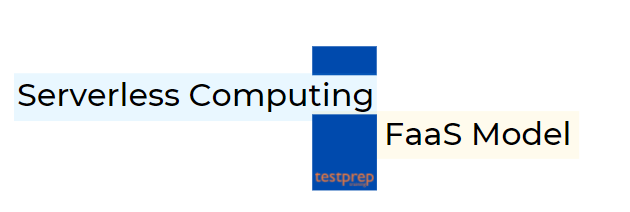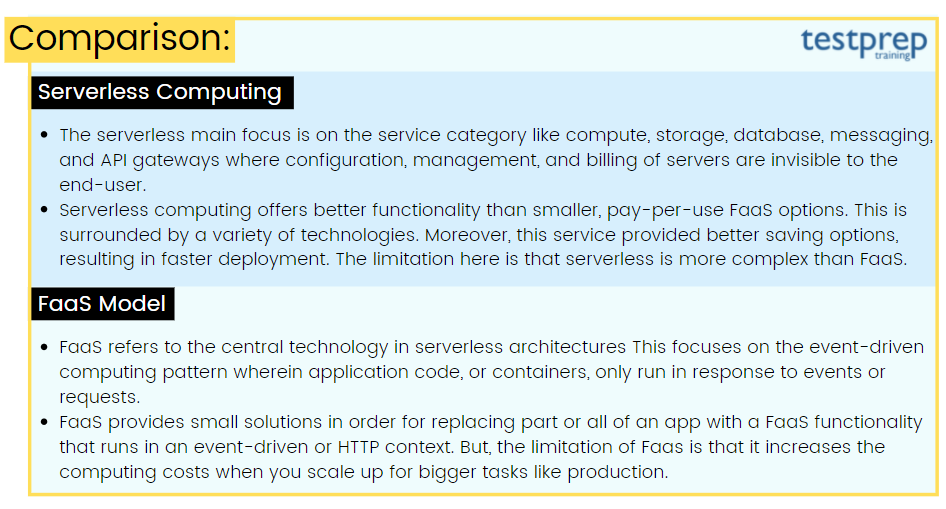A few years back organizations have to manage the servers themselves using the physical resources. This as a result increases the cost, maintenance, and resources work. But, as soon as the Cloud computing sector started to emerge, new services and solutions were being introduced. For overcoming the server problem, a cloud computing execution model that is serverless computing came into the spotlight.
Serverless computing is used for helping the cloud provider for allocating machine resources on-demand and handling the servers. This service simplifies the process of deploying code into production. In which, serverless code can be used in conjunction with code deployed in traditional styles like microservices. But, what is the role of the FaaS (Function-as-a-service) model in serverless computing?
For finding the answer to this question, in this blog, we will cover all the details related to the FaaS model and Serverless computing for understanding how they are linked using the examples. So, let’s begin with an overview of serverless computing.
What is Serverless computing?
Serverless computing helps developers for building applications more fastly by removing the requirement for managing infrastructure. Using serverless applications, the cloud service can automatically provisions, scales, and manages the infrastructure need for running the code.
However, you must know that in serverless computing, the servers are still running the code. The term serverless means that the tasks linked with infrastructure provisioning and management are invisible to the developer. This further helps developers to increase their focus on the business logic and deliver more value to the core of the business.
Benefits of serverless computing:
- Firstly, there no requirement for managing infrastructure. This service is fully managed which helps developers for avoiding administrative tasks and focus on core business logic.
- Secondly, using serverless computing, the infrastructure dynamically scales up and down within seconds for matching the demands of any workload.
- Thirdly, serverless applications help in reducing the operations dependencies on each development cycle. Further, increasing development teams’ agility for delivering more functionality in less time.
- Lastly, this technology helps organizations to reduce TCO and reallocate resources for accelerating the pace of innovation.
Serverless application patterns
Developers build serverless applications using different application patterns. Out of which many align with approaches that are already familiar for meeting specific requirements and business needs.
1. Serverless functions
This helps in accelerating the development by using an event-driven model, with triggers that automatically run code to respond to events and bindings to smoothly integrate additional services.
2. Serverless Kubernetes
Developers bring their own containers to fully managed, Kubernetes-orchestrated clusters that have the ability to automatically scale up and down with sudden changes in traffic on spiky workloads.
3. Serverless workflows
This pattern takes a low-code/no-code approach for simplifying the orchestration of combined tasks. Moreover, developers can integrate various services without coding those interactions, or learning new APIs or specifications.
4. Serverless application environments
Using this, both the back end and front end are hosted on fully managed services that control scaling, security, and compliance requirements.
5. Serverless API gateway
This refers to a centralized, fully managed entry point for serverless backend services. Moreover, it helps developers for publishing, securing, managing, and analyzing APIs on a global scale.
Use cases for Serverless Computing
1. Building scalable, secure web apps
Coding, building, and deploying scalable applications in a completely managed environment planned for helping developers succeed. This provides built-in security, autoscaling, and ops management for faster deployment.
2. Developing, deploying, and managing APIs
Creating scalable APIs in an environment built for developers to succeed. Using this, you can develop REST APIs for web and mobile backends as well as manage the connection between various parts of your application and internal cloud services with our internal APIs and services.
3. Build apps with data processing in mind
A serverless computing environment manages the infrastructure workloads need, for handling autoscaling, authorization, and event triggers. The pub/sub model of communication makes it easy for ingesting and transforming large amounts of data and build complex, scalable data pipelines while saving time on backend confusion.
4. Automating event orchestration
Automatically validating policies or configurations and performing other scripted automation using event triggers. Serverless computing products can listen to events from other clouds, and manage to distribute events and workloads to other components.

Moving on to the FaaS model.
What is FaaS (Function-as-a-Service)?
FaaS is a cloud computing service used for providing a simple path to cloud application developers for running and managing microservices applications. FaaS (Function-as-a-Service) is a subset of serverless computing that provides access to run code in response to events without the complex infrastructure typically linked with creating and launching microservices applications.
Further, using FaaS, the cloud service provider can control the physical hardware, virtual machine operating system, and web server software management.
Benefits of FaaS
- Firstly, this service allows you to focus more on code than infrastructure. In this, you can divide the server into functions for scaling automatically and independently.
- Secondly, you only have to pay for the resources you use. After using them, everything stops and there will be no code execution, server idles, costs. That is to say, FaaS is cost-effective for dynamic workloads or scheduled tasks.
- Thirdly, in this, the functions are automatically scaled up and down as required. However, when there is a drop in the demand, FaaS automatically scales back down.
- Lastly, it offers inherent high availability. That is to say, it is spread over multiple availability zones per geographic region and can be deployed across any number of regions without incremental costs.
Use cases of FaaS Model
- FaaS (Function-as-a-Service) helps transactions to be easily isolated and scaled.
- Secondly, it is good for high-volume parallel workloads which can be used for creating backend systems or for activities such as:
- data processing
- format conversion
- encoding
- data aggregation.
- Thirdly, this is the best tool for Web applications, backends, data/stream processing, or for creating online chatbots or back ends for IoT devices.
- Next, this helps in managing and using third-party services. Moreover, here you can keep a check on costs. Because this will only charge when your application connects to the cloud for a specific function like batch processing.
- Lastly, this can dramatically boost computing performance.
Above we have understood the overview and features of serverless computing and the FaaS model. In the next section, we will understand how they both relate to each other.
FaaS and serverless: Comparison
Serverless computing and Functions-as-a-Service (FaaS) models are often united with one another. But you must know that FaaS is basically a subset of serverless computing. However, to better understand check out the comparison table below.

Moving on, in this next section, we will learn about the top examples of both Serverless computing and the FaaS model.
Serverless Computing and FaaS Model: Examples
1. AWS Lambda
- AWS Lambda refers to a serverless compute service used for running code without any need for:
- provisioning or managing servers
- building workload-aware cluster scaling logic
- maintaining event integrations
- managing runtimes.
- However, this service gives the best example of serverless computing. By using Lambda, you can run code for virtually any type of application or backend service. That is to say, you have to only upload code as a ZIP file or container image. Then, Lambda automatically assigns compute execution power and runs your code depending on the incoming request or event, for any scale of traffic.
- Lastly, you only pay for the compute time you consume. That is to say, you are never paying for over-provisioned infrastructure. This service charges for every millisecond your code executes and the number of times the code triggers.
2. Google Cloud Functions
Google Cloud functions refer to scalable pay-as-you-go functions as a service (FaaS) for running your code with zero server management. In this,
- Firstly, there is no requirement of servers for provisioning, managing, or upgrading
- Secondly, this automatically scale depending on the load
- Thirdly, there is integrated monitoring, logging, and debugging capability
- Next, there is built-in security at the role and per function level depending on the principle of least privilege
- Lastly, key networking abilities for hybrid and multi-cloud scenarios
Further, Google Cloud Functions provides a simple developer experience. That is to say, you have to only write your code and let Google Cloud handle the operational infrastructure. Talking about the billing part, you will get a bill for your function’s execution time only which is metered to the nearest 100 milliseconds. So, there is no cost when your function is idle. Lastly, it uses the open-source FaaS (function as a service) framework for running functions over multiple environments and prevents lock-in.
3. Azure Functions
Azure functions accelerate and simplify serverless application development by using serverless computing. This refers to an event-driven serverless compute platform that helps in developing Functions for solving complex orchestration problems. This allows you to create and debug locally without:
- additional setup
- deploying and operating at scale in the cloud
- integrating services using triggers and bindings.
Further, using Azure Functions you can take advantage of a complete development experience with Functions. This allows to create and debug locally on major platforms like Windows, macOS, and Linux to deploying and monitoring in the cloud. Moreover, you can simplify complex coordination requirements programmatically in event-driven applications using the Durable Functions extension. Lastly, this allows you to select the Functions plan that matches your business requirements and deploy the same code to multiple targets using pay-per-execution in the cloud to IoT devices for edge computing.
Final Words
Above we have understood the Serverless computing and FaaS model by explaining features, examples, and a quick comparison between these. However, you must know that the serverless approach offers developers, teams, and organizations a level of abstraction which helps them for minimizing the time and resources invested in infrastructure management. Using a serverless platform provides a comprehensive set of serverless technologies that offers the best way for gaining maximum benefits for the organization. So, learn about the serverless services and reach out in the comments if there is any doubt.



